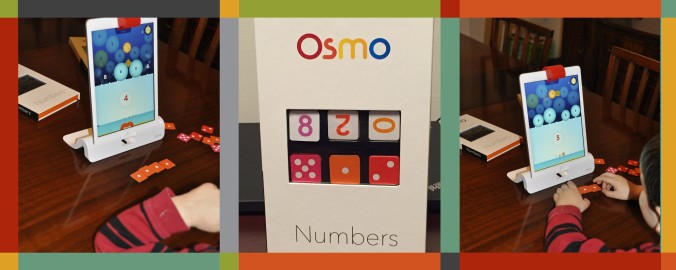Rory was playing the Osmo Numbers Game (he was pretty spoiled by Santa this year!), and he was getting really frustrated because the game wanted him to make the number 12, and he kept doing 1 and 2 (instead of 10 and 2) and not getting it right. This led me to wonder how I could help him understand the difference between digits and their place in numbers.

Oliver learning numbers with Osmo.
Rory is in kindergarten and has no understanding of place value yet, although he should start learning about numbers greater than 10, in school soon. To help him realize that 12 is different from 1 and 2, he needs help conceptualizing the idea that one 10 is different from one 1.
“They must be able to conceptualize place value; the understanding that the same numeral represents different amounts depending on which position it is in.” Charlesworth, 2012.

Rory trying to make 14 with the digits 1 and a 4; then making 14 by adding 10 and some more.
Knowing the difference between digits and numbers is a developmental milestone and comes with a strong understanding of place value. I often have primary teachers ask, if I have any ideas on how to make this difference more apparent, and I do!
There are 3 main strategies you can use to develop this understanding:
1) Concrete representation of numbers
Use manipulatives to build the numbers. Showing the difference between 1 and 2 and 10 and 2 using a rekenrek, counters or unifix cubes clearly demonstrates that the digit in the ones position is different from the digit in the tens position. (If this doesn’t make sense, watch the video below!) Grouping or bundling things into groups of 10, or using base 10 blocks, is the best way for students to visualize the difference. Make sure you give lots of time for them to practice counting objects and grouping them into bundles of 10.
“A set of ten should figure prominently in the discussion of the teen numbers” Van de Walle, 2014.
2) Patterns
Write the numbers vertically and ask the students to notice any patterns they see. You will be surprised at your student’s or child’s ability to see that numbers repeat from 0-9, or that all the teen numbers have a one in front of it. Bring in the 100 chart! Now you’ve got a starting place for inquiry…why do they all have a one in front? Your goal is to have students come away with the understanding that digits mean different things when they are in different places.
3) Addition
In order to build number sense, you want students to think flexibly about numbers. In other words, can they decompose a number and can they do it in more than one way? When introducing numbers greater than 10, you want your child to decompose them into 10 and some more. This is another reason I love the rekenrek, for its amazing ability to show a number as 10 and some more.
“Mapping the teens number names to a ten and one structure is an important idea.” Van de Walle, 2014.
Counters are great too because they give students practice creating that group of 10: count out 13 ones, but if you group your tens…you have one ten and 3 more. Representing this as an addition sentence is another great connection for your kids to make and is the beginning of learning signs and symbols to represent math problems.
Here is a video of Rory and I learning about numbers greater than 10. Watching it back, I would have done a few things differently (like have my husband look after Oliver!), but I still think it gives you an idea of the 3 strategies in action (concrete manipulatives, patterns and addition)!
Do you have other suggestions of how to build the understanding that digits are different from numbers? I’d love to hear them! Please share them in the comments section below.
Back to top
Pingback: Double Digit Addition: Delaying the Algorithm | Math Milestones with my little men
Pingback: Teen versus Ty numbers | Math Milestones with my little men